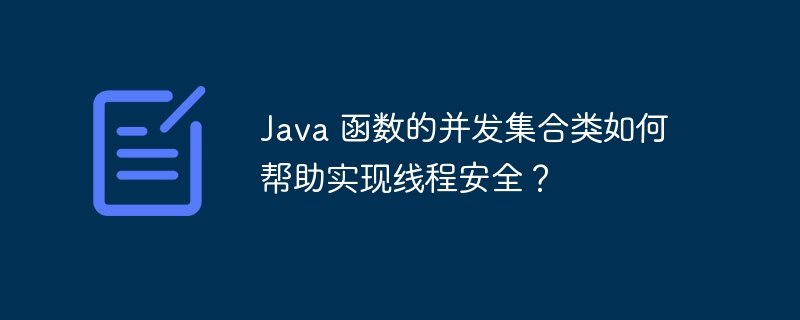Home >Java >javaTutorial >How does the concurrent collection class of Java functions help achieve thread safety?
How does the concurrent collection class of Java functions help achieve thread safety?
- WBOYWBOYWBOYWBOYWBOYWBOYWBOYWBOYWBOYWBOYWBOYWBOYWBOriginal
- 2024-05-01 21:18:02966browse
Java concurrent collection classes help achieve thread safety by providing a thread-safe mechanism to access and operate shared data: ConcurrentHashMap: A thread-safe hash table that supports concurrent insertion, deletion, and search. CopyOnWriteArrayList: Thread-safe ArrayList, a copy will be created every time it is modified. BlockingQueue: Thread-safe queue for producing and consuming elements among multiple threads.

How the concurrent collection class of Java functions helps achieve thread safety
Thread safety is a crucial one in multi-threaded programming concept. In a multi-threaded environment, when multiple threads access shared data, the data may be corrupted, causing the program to behave unexpectedly.
To solve this problem, Java provides a series of concurrent collection classes that provide thread-safe mechanisms for accessing and operating shared data. These classes include:
- ConcurrentHashMap: A thread-safe hash table that allows concurrent insertion, deletion, and searching of elements.
- CopyOnWriteArrayList: A thread-safe ArrayList that creates a new copy every time the list is modified.
- BlockingQueue: A thread-safe queue for producing and consuming elements between multiple threads.
Using these concurrent collection classes, you can easily implement thread-safe code. Here is an example using ConcurrentHashMap:
import java.util.concurrent.ConcurrentHashMap;
public class ThreadSafeMapExample {
public static void main(String[] args) {
// 创建一个 ConcurrentHashMap
ConcurrentHashMap<Integer, String> map = new ConcurrentHashMap<>();
// 多个线程并发写入数据
Thread[] threads = new Thread[10];
for (int i = 0; i < threads.length; i++) {
threads[i] = new Thread(() -> {
for (int j = 0; j < 100; j++) {
map.put(j, "Value-" + j);
}
});
threads[i].start();
}
// 等待所有线程完成
for (Thread thread : threads) {
try {
thread.join();
} catch (InterruptedException e) {
e.printStackTrace();
}
}
// 输出 ConcurrentHashMap 中的数据
for (int i = 0; i < 100; i++) {
System.out.println(map.get(i));
}
}
} In this example, we create a ConcurrentHashMap and then use 10 threads to write data concurrently. Since ConcurrentHashMap is thread-safe, the data is not corrupted and we are able to output the correct results after the program completes.
It should be noted that the concurrent collection class is not completely thread-safe. In some cases, if you perform complex operations or traversals on the data, you will still need to use additional synchronization mechanisms.
The above is the detailed content of How does the concurrent collection class of Java functions help achieve thread safety?. For more information, please follow other related articles on the PHP Chinese website!

